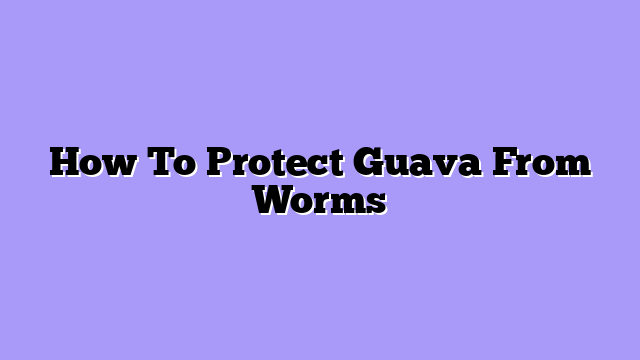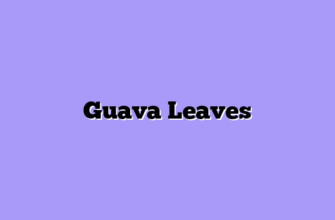Let me tell you about the time I almost lost half my Psidium guajava crop to those sneaky fruit flies and their wormy offspring. It was a wake-up call that changed how I approach protecting my precious guava trees (or as my Portuguese friends call them, goiabeira). Whether you’re growing these tropical treasures commercially like me or tending to a backyard tree, dealing with fruit flies and their larvae is like playing chess with a very persistent opponent.
After nearly two decades of growing what my Filipino workers call bayabas and my Indian friends know as amrood, I’ve learned that preventing worm infestations is much like running a tight ship – it requires vigilance, strategy, and sometimes, learning things the hard way. Trust me, there’s nothing more heartbreaking than cutting open what looks like a perfect fruit only to find unwanted guests have made it their home.

Think of fruit flies like tiny stealth bombers – they’re always scanning for the perfect moment to strike. But don’t worry, I’ve developed a comprehensive defense system that works wonders, and I’m excited to share these battle-tested strategies with you.
Understanding Your Enemy
First things first – know your enemy. The main culprits attacking our guavas (known as goiaba in Brazil) are fruit flies that lay their eggs in the developing fruit. These eggs hatch into those dreaded worms that can turn a perfect fruit into a nightmare. It’s like having uninvited guests crash your carefully planned party!
The fascinating (and frustrating) thing about these pests is their incredible sense of timing. They can detect a fruit’s ripening stage with remarkable precision, much like a master chef knowing exactly when a dish is perfectly cooked. The flies typically strike when the fruit is just beginning to mature, ensuring their offspring have the best possible environment to develop.
I’ve spent countless hours observing these insects on my farm, and I’ve noticed they’re most active during the warmer parts of the day. They’re particularly attracted to fruits that are starting to turn from green to yellow – that’s when the fruit’s defenses are naturally starting to lower, making it the perfect time for these opportunistic pests to strike.
Understanding this behavior is crucial because, as I always say, “You can’t outsmart an enemy you don’t understand.” It’s like playing chess – you need to anticipate your opponent’s next move to protect your pieces effectively.
Prevention: Your First Line of Defense
In my years of protecting goyavier (as it’s known in French), I’ve learned that prevention is worth a pound of cure. Here’s my proven prevention strategy that has dramatically reduced worm problems on my farm:
- Fruit Bagging
- Use specialized paper bags or old newspaper
- Cover fruits when they’re marble-sized
- Ensure bags have small drainage holes
- Check and replace damaged bags weekly
- Orchard Sanitation
- Remove fallen fruits daily
- Dispose of infected fruits properly
- Maintain clean surroundings
- Prune regularly to improve air circulation
I implement these measures as religiously as a daily shower – it’s just part of my routine now. Think of it as creating a fortress around your fruits. Yes, it takes time and effort, but it’s far better than losing your precious harvest to those persistent pests.
Natural Control Methods
One of my favorite aspects of protecting posh (as guava is known in some parts of India) is using nature’s own defense mechanisms. I’m a big believer in working with nature rather than against it. Here’s what’s worked wonderfully on my farm:
First, I maintain a healthy population of beneficial insects by planting companion flowers around my orchard. These natural predators act like my own personal army, keeping the fruit fly population in check. Marigolds, nasturtiums, and sweet alyssum are my go-to choices – they’re like a welcome mat for helpful insects.
I’ve also had great success with neem-based solutions. Neem is like nature’s own pesticide, and when used correctly, it can be incredibly effective without harming beneficial insects or leaving harmful residues on the fruit. I apply it early in the morning or late in the evening when beneficial insects are less active.
Pheromone traps are another game-changer. Think of them as nightclubs for male fruit flies – they’re irresistibly attracted to these traps, which helps break the breeding cycle. I place these traps strategically around my orchard, about one per every five trees.
Chemical Controls: The Last Resort
Look, I’m going to be straight with you – sometimes, despite our best natural efforts, we need to bring in the heavy artillery. But here’s the key: chemical controls should be your last line of defense, not your first response. It’s like having a fire extinguisher – you hope you never need it, but you’re glad it’s there when you do.
When I do need to use chemical controls, I follow a strict protocol. Timing is crucial – applications need to happen before the flies lay their eggs, just as the fruits are beginning to develop. I always use the minimum effective dose and follow safety guidelines religiously. Remember, we’re growing food here, not conducting chemical warfare!
I maintain detailed records of any chemical applications, including what was used, when, and how effective it was. This helps me fine-tune my approach and, importantly, ensures we’re maintaining proper pre-harvest intervals. Your customers’ safety should always be your top priority.
One thing I’ve learned is that rotating between different types of approved pesticides helps prevent resistance development. It’s like changing up your workout routine – if you do the same thing all the time, it becomes less effective.
Monitoring and Maintenance
Success in protecting your guavas comes down to consistent monitoring and maintenance. I walk through my orchard every morning, just like a doctor doing their rounds. I’m looking for early signs of trouble – fruit flies hovering around trees, fruits with small puncture marks, or any other suspicious activity.
I keep a detailed log of what I observe and what measures I take. This helps me track patterns and adjust my strategies accordingly. Over time, these observations become invaluable data that helps predict and prevent future problems.
Regular pruning and maintaining proper tree spacing is crucial too. Think of it as social distancing for your trees – good air circulation and sunlight penetration make it harder for pests to establish themselves. I ensure my trees are pruned to maintain an open center, which also makes it easier to spot and deal with any problems early on.
Remember, protecting your guava trees from worms isn’t a one-time thing – it’s an ongoing process that requires dedication and attention to detail. But trust me, when you bite into a perfect, worm-free fruit that you’ve protected from seed to harvest, it makes all the effort worthwhile!








